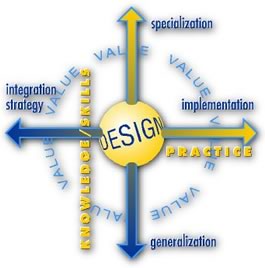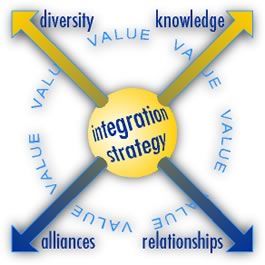
Integrator and/or Integratee

by Richard W. Hobbs, FAIA
AIA Resident Fellow, Marketplace Research and Trends
I would first like to share some of the lively response to my recent columns about the current exploration of the Redefinition matrix and the notion of "Architect as Integrated Service Provider."
A matter of terminology: Some readers expressed concern about using the term "integrated service provider (ISP)" to describe what architects do. The concerns ranged from "we have always done that" to "ISP in computer terminology for internet service provider; laypeople may suspect we can't define ourselves without using another industry's terms." When management guru Tom Peters used the term "integrated" as he addressed the AIA convention, he was indeed using other industries' terminology—demonstrating the need for integration and a holistic approach in business.
William Evans, AIA, points out that professional definitions today are blurred. Other professions liberally use "architect," such as in "software architect." Architecture in computerese and general usage defines a framework or an organizational strategy. Wow! That is what architects mean by "architecture"—and it seems other fields have adopted it as their own.
 Evans'
skepticism centers on codifying a process as complicated as design. He
says "success in design results from a synthesis of listening to
clients, letting the right brain do its thing," and applying lessons
learned from experience—"all of that on the design side."
Then, on the production side, you need the left-brained problem solving,
coordination, and "communication, communication, communication."
He agrees there is a place for integration.
Evans'
skepticism centers on codifying a process as complicated as design. He
says "success in design results from a synthesis of listening to
clients, letting the right brain do its thing," and applying lessons
learned from experience—"all of that on the design side."
Then, on the production side, you need the left-brained problem solving,
coordination, and "communication, communication, communication."
He agrees there is a place for integration.
Individuals vs. process?: Robert Lund, AIA, was concerned that the ISP concept, as described in the DiSC Personal Profile System article, centered on the individual rather than the process. Lund would describe this process as asking the right questions and providing clear direction through a well-conceived scope of services. True, the DiSC system may focus on the individual, yet it really concerns the process implemented by a number of individuals to maximize integration of services.
 If
we diagram this integration of services, it forms a perfect overlay to
our Redefinition matrix. If we superimpose the integration diagram on
the Practice axis of the matrix, we see a bubble with its own sections
of knowledge, diversity, relationships, and alliances.
If
we diagram this integration of services, it forms a perfect overlay to
our Redefinition matrix. If we superimpose the integration diagram on
the Practice axis of the matrix, we see a bubble with its own sections
of knowledge, diversity, relationships, and alliances.
Alliances are the
basis of integration
How do you create a framework to become integrated? You can form an alliance—and
you can be an "integrator" or an "integratee." You
can base your alliance on one particular project or on an ongoing business
strategy. In a project alliance, you are working with others to achieve
one goal: a successful one-shot project. In a strategic business alliance,
you are building on ongoing strength with overwhelming professional potential.
Insight Alliance—composed of architecture firms Callison; TVS; and Wimberly Allison Tong & Goo—offers a great example of a strategic alliance. Their shared objective is to offer the absolute best knowledge/value to and on behalf of their clients. Their combined synergy produces a broader wealth of knowledge and intellectual capital and deeper expertise than do large, generalist architecture firms.
Insight Alliance began creating this business alliance by exploring and discovering areas of overlapping strengths. They share the drive for constant improvement, raising the intellectual base, building a shared knowledge base, and providing cost efficiencies to benefit both the client and the firms. In other words, they offer greater value throughout the overall design process.
Building alliances
Reasons for building a strategic alliance vary with the individual firm,
and can include to:
• Expand geographically without branch offices
• Find a means of entering the international market
• Overlap various aspects of a building type or service, providing
greater depth in a building type, or new combination of uses
• Provide greater value through greater and integrated resources
• Cultivate an intellectual capital unsurpassed in the profession
• Jump-start an integrated organization.
 How
does one locate potential alliance partners? You might start by networking
at AIA activities, where you meet individuals and firm representatives
and assess the strengths they offer. You might also do some research,
using resources such as the CMD ProFile
and the Internet. The next step might be adding partners to further the
firm's expertise and knowledge flow.
How
does one locate potential alliance partners? You might start by networking
at AIA activities, where you meet individuals and firm representatives
and assess the strengths they offer. You might also do some research,
using resources such as the CMD ProFile
and the Internet. The next step might be adding partners to further the
firm's expertise and knowledge flow.
Regardless of how you go about it, you need to realize
that to form an alliance, you need to be able to:
• Swallow your competitive nature
• Communicate everything to each other
• Realize that you are forming a family and need to get to know each
other
• Commit to the investment of time and energy to understand how incredible
the partnership has the potential to be.
The alliance may go beyond architects to a professional diversity with experts—perhaps even the ultimate "niche specialist"—to focus on creating the alliance. It might mean considering a series of "preferred providers" who will help the alliance partners customize and package that special value for the client. Creating a strategic alliance is like throwing a rock in the lake—it has a ripple effect.
Trends we're seeing
in our marketplace research
• Clients today have the complexity and sophistication to offer multidisciplinary
teams great opportunities for professional diversity
• Clients are choosing to work with teams that have the knowledge
and intellectual capital to strategize, design, and implement an entire
project
• Clients recognize the value and competitive advantages of alliances
• Clients demand to work with people who create value through collaboration,
coordination, facilitation, and integration.
In fact, some prognosticators believe that there
will be three major practice models for architects in the future:
• A small number of the large, totally integrated service firms
• Strategic alliances
• Niche market, knowledge specialists.
What are you finding? Where do you see opportunity for the profession? Send your response to rhobbs@richardwhobbs.com.
Copyright 2002 The American Institute of Architects. All rights reserved.
![]()
|
Respond to the author by email. The author would like to acknowledge the research resources contributed by the Wallace Research Group |
|